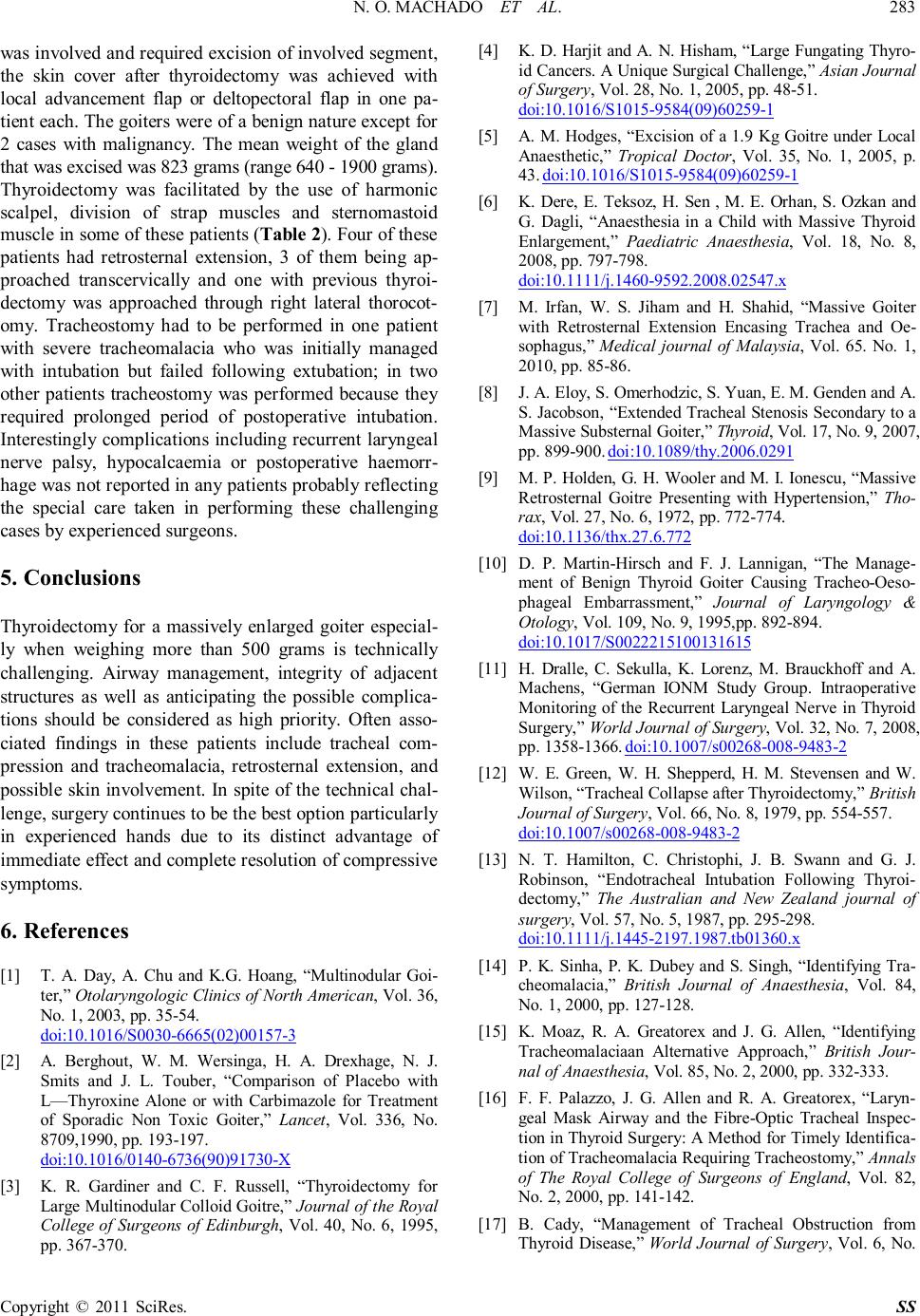
N. O. MACHADO ET AL.
Copyright © 2011 SciRes. SS
was i n vol ved a n d re qui r ed ex ci si on of i n vol v ed seg m en t ,
the skin cover after thyroidectomy was achieved with
local advancement flap or deltopectoral flap in one pa-
ti en t each . Th e goi ter s were of a ben ign na tur e except for
2 cases with malignancy. The mean weight of the gland
that was excised was 823 grams (range 640 - 1900 gr am s ).
Thyroidectomy was facilitated by the use of harmonic
scalpel, division of strap muscles and sternomastoid
mu scl e in som e of th ese p ati ent s (Table 2). Fou r of these
patients had retrosternal extension, 3 of them being ap-
proached transcervically and one with previous thyroi-
dectomy was approached through right lateral thorocot-
omy. Tracheostomy had to be performed in one patient
with severe tracheomalacia who was initially managed
with intubation but failed following extubation; in two
other patients tracheostomy was performed because they
required prolonged period of postoperative intubation.
Interestingly complication s including recurrent laryngeal
nerve palsy, hypocalcaemia or postoperative haemorr-
hage was not reported in an y pa tients probably reflecting
the special care taken in performing these challenging
cas es b y exper ienced s urgeons.
5. Conclusions
Thyroidect omy for a massively enlarged goiter especial-
ly when weighing more than 500 grams is technically
challenging. Airway management, integrity of adjacent
structures as well as anticipating the possible complica-
tions should be considered as high priority. Often asso-
ciated findings in these patients include tracheal com-
pression and tracheomalacia, retrosternal extension, and
possible skin involv ement. In spite of the techn ical ch al-
lenge, surgery con tinues to be the be s t opt ion particularly
in experienced hands due to its distinct advantage of
immedi ate effect an d complete resolution of compressive
symptoms.
6. References
[1] T. A. Day, A. Chu and K.G. Hoang, “Multinodular Goi-
ter,” Otolaryngologic Clin ics of Nort h American, Vol. 36,
No. 1, 2003, pp. 35-54.
doi:10.1016/S0030-6665(02)00157-3
[2] A. Berghout, W. M. Wersinga, H. A. Drexhage, N. J.
Smi ts and J. L. Touber, “Comparison of Placebo with
L—Thyroxine Alone or with Carbimazole for Treatment
of Sporadic Non Toxic Goiter,” Lancet, Vol. 336, No.
8709,1990, pp. 193-197.
doi:10.1016/0140-6736(90)91730-X
[3] K. R. Gardiner and C. F. Rus sell, “Thyroidectomy for
Large Multinodular Colloid Goitre,” Journal of the Royal
College of Surgeons of Edinburgh, Vol. 40, No. 6, 1995,
pp. 367-370.
[4] K. D. Harjit and A. N. Hisha m, “Large Fungating Thyro-
id Cancers. A Unique Surgical Challenge,” A sian J our nal
of Surge ry, Vol. 28, No. 1, 2005, pp. 48-51.
doi:10.1016/S1015-9584(09)60259-1
[5] A. M. Hodges, “Excis ion of a 1. 9 Kg Goitr e und er Local
Anaesthetic,” Tropical Doctor, Vol. 35, No. 1, 2005, p.
43. doi:10.1016/S1015-9584(09)60259-1
[6] K. Dere, E. Teksoz, H. Sen , M. E. Orhan, S. Ozkan and
G. Dagli, “Anaesthesia in a Child with Massive Thyroid
Enlargement,” Paediatric Anaesthesia, Vol. 18, No. 8,
2008, pp. 797-798.
doi:10.1111/j.1460-9592.2008.02547.x
[7] M. Irfan, W. S. J ih am and H. Sh ahid, “Massive Goiter
with Retrosternal Extension Encasing Trachea and Oe-
sophagus,” Medical journal of Malaysia, Vol. 65. No. 1,
2010, pp. 85-86.
[8] J. A. Eloy, S. Omerhodzic, S. Yuan, E. M. Genden and A.
S. Jacobson, “Extended Tracheal Stenosis Secondary t o a
Massive Substernal Goiter,” Thyroid, Vol. 17, No. 9, 2007,
pp. 899-900. doi:10.1089/thy.2006.0291
[9] M. P. Holden, G. H. Wooler and M. I. Ionescu, “Massive
Retrosternal Goitre Presenting with Hypertension,” Tho-
rax, Vol. 27, No. 6, 1972, pp. 772-774.
doi:10.1136/thx.27.6.772
[10] D. P. Martin-Hirs ch and F. J. Lannigan, “The Manage-
ment of Benign Thyroid Goiter Causing Tracheo-Oeso-
phageal Embarras sment,” Journal of Laryngology &
Otology, Vol. 109, No. 9, 1995,pp. 892-894.
doi:10.1017/S0022215100131615
[11] H. Dralle, C. Sekulla, K. Loren z , M. Brauckhoff and A.
Machens, “German IONM Study Group. Intraoperative
Moni toring of t he Recurrent Laryngeal Nerve in Thyroid
Surgery,” Wor ld J ou r nal of Sur g er y, Vol. 32, N o. 7, 2008,
pp. 1358-1366. doi:10.1007/s00268-008-9483-2
[12] W. E. Green, W. H. Shepperd, H. M. Stevensen and W.
Wilson, “Tracheal Collapse a f ter Thyroidectomy,” Britis h
Journal of Surgery, Vol. 66 , N o. 8, 1979, pp. 554-557.
doi:10.1007/s00268-008-9483-2
[13] N. T. Hamilton, C. Christophi, J. B. Swann and G. J.
Robinson, “Endotracheal Intubation Following Thyroi-
dectomy,” The Australian and New Zealand journal of
surgery, Vol. 57, N o. 5, 1987, pp. 295-298.
doi:10.1111/j.1445-2197.1987.tb01360.x
[14] P. K. Sinha, P. K. Dubey and S. Singh, “Identifying Tra-
cheomalacia,” British Journal of Anaesthes ia, Vol. 84,
No. 1, 2000, pp. 127-128.
[15] K. Moaz, R. A. Greatorex and J. G. Alle n, “Identifying
Tracheomalaciaan Alte rn ative Approach,” British Jour-
nal of Anaesthesi a, Vol. 85, No. 2, 2000, pp. 332-333.
[16] F. F. Palazzo, J. G. Allen and R. A. Greatorex, “Laryn-
geal Mask Airway and the Fibre-Optic Tracheal Inspec-
tion in Thyroid Surgery: A Me th od for Timely Identifica-
t ion of Tracheomalacia Requiring Tracheostomy,” Annals
of The Royal College of Surgeons of England, Vol. 82,
No. 2, 2000, pp. 141-142.
[17] B. Ca dy, “Management of Tracheal Obstruction from
Thyroid Disease,” World Journal of Surgery, Vol. 6, No.